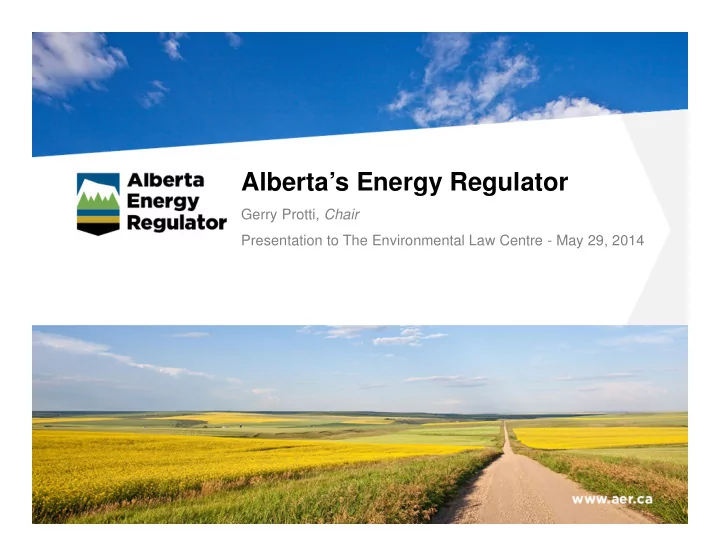

Alberta’s Energy Regulator Gerry Protti, Chair Presentation to The Environmental Law Centre - May 29, 2014
One Province. One Regulator Government of Alberta created first regulator 76 years ago Mandate has evolved over time Responsibilities and functions have expanded Alberta Energy Regulator: Alberta’s single, full life-cycle regulator of energy development 2
AER Mandate The Alberta Energy Regulator ensures the safe, efficient, orderly, and environmentally responsible development of hydrocarbon resources over their entire life cycle. This includes allocating and conserving water resources, managing public lands, and protecting the environment while providing economic benefits for all Albertans. 3
Governance 4
Integrated Resource Management System 5
6
Building the AER December 2012 REDA June 17, 2013 the AER launched December 1, 2013 Public Lands Act Mines and Minerals Act (Part 8) April 1, 2014 Environmental Protection and Enhancement Act Water Act 7
AER VISION AND STRATEGIC PRIORITIES 8
AER Vision The Alberta Energy Regulator is recognized as best-in-class, ensuring the safe, environmentally responsible development of energy resources for the benefit of all Albertans. 9
AER Strategic Priorities Protective – public safety, cumulative environmental impacts Play based regulation, air emissions, IRMS Effective – resource conservation, infrastructure liability management Aging infrastructure, reservoir containment, pipeline integrity Efficient – efficient processes and requirements Continuous improvement, regulatory simplification Credible – confidence and trust in regulatory system Best in class, performance monitoring & reporting ��
Play Based Regulation Responding to intensity, duration, and scale of development: Organize risks by play, integrate surface & subsurface Regulatory response proportional to risk Holistic planned approach to development Integrated/bundled authorizations Performance/outcome based Increase planning & collaboration amongst companies & community stakeholders ��
Operator Play Based Project Plans Include: Water Management Play or project level plan Surface infrastructure development Minimize footprint, linear disturbances, trucking, noise, emissions, etc Sub-surface reservoir management Resource recovery, minimize flaring, ER potential, reserves assessment Stakeholder engagement Local community, business leaders, local authorities Lifecycle wellbore Integrity Fit with overarching land use and watershed plans
Play Based Regulation Outcomes Managing cumulative effects Improving efficiencies Meeting subsurface requirements Minimizing spread of surface infrastructure Conserving and managing water Sharing and collaborating with stakeholders Aligning with GOA policies ��
Participation at AER Hearings 14
Directly and Adversely Affected Test The AER reviews every statement of concern Each statement of concern is unique; therefore, specifics are considered Treaty and traditional use activities are considered for First Nations and Metis Determinations of direct and adverse affects may result in hearings 15
CNRL Kirby Expansion Project Hearing canceled by the AER because no specific traditional use activities or sites near the project identified by First Nations SOC filers OSEC SOC filed on behalf of trapline holder who later confirmed support of the application, and generic concerns that relate to government policy 16
Commitment to Transparency On line oil and gas incident reporting Posting public notices of applications and decisions online Inviting statements of concern Live streaming audio from public hearings Social media expansion Extensive meetings with Albertans and others Annual Report to Albertans in June 17
18 18
Recommend
More recommend